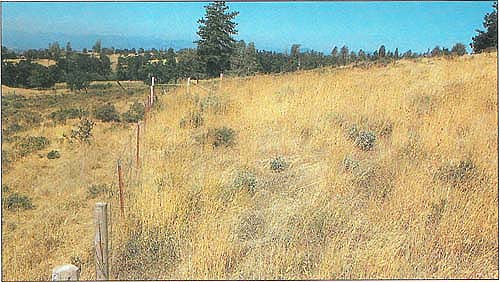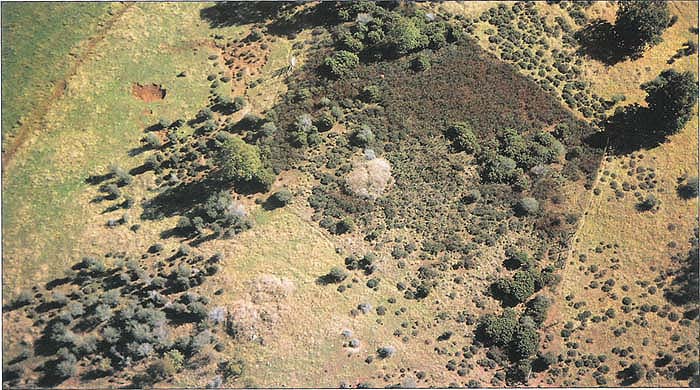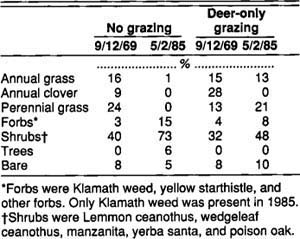All Issues
Grazing helps maintain brush growth on cleared land
Publication Information
California Agriculture 44(5):31-35.
Published September 01, 1990
PDF | Citation | Permissions
Abstract
A 20-year photographic record shows that grazing by deer and cattle can maintain forage after brush clearing.
Full text
For decades, California ranchers have reduced brush cover to increase livestock forage. Brush control has also reduced fire hazard and soil erosion, increased water yield, and often improved wildlife habitat. Browsing by cattle and deer slowed the regrowth of brush and postponed the need for follow-up mechanical, chemical, or burning treatments. A 20-year photographic record and transect data show how browsing by deer only and by cattle and deer can maintain forage appropriate for deer and livestock.
Demonstration area
The demonstration site is on a ranch in the Sierra Nevada foothills, 22 airline miles east of Redding and 2,200 feet above sea level. Summers are warm and dry with temperatures up to or above 100°F; winter minimums may go below 20°F. Annual precipitation averages 50 to 55 inches. Snow falls five or six times each winter. The soil is a fineloamy, mixed, mesic pachic argixeroll identified as Supan gravelly loam in the 1974 USDA Soil Survey of Shasta County.
The site is on a small hill in a large cleared area just below the edge of an extensive ponderosa pine forest. Irrigated swales nearby may increase cattle use of the study area. Surrounding vegetation includes blue oak, digger pine, manzanita, Ceanothus species, annual grasses, forbs, legumes, and occasional patches of live oak, black oak, and ponderosa pine. Cattle usually graze from March into November. Deer migrate through the area from March to April and October to November.
In 1960, bulldozers cleared brush and some trees from the area. After clearing, the area was seeded with rose clover, subterranean clover, and harding grass. Livestock and deer used the site for 9 years until the California Department of Fish and Game helped build two contiguous exclosures in 1969 on an area of about 0.9 acres. One exclosure allowed access for deer, but not for cattle. The other, made of woven wire 8 feet high, excluded both deer and cattle. In September 1976, 300 pounds per acre of single superphosphate fertilizer was applied by airplane.
Exclosure monitoring
On September 12, 1969, the same year the exclosures were built, the plant composition within each exclosure was recorded on four step-point transects. Each transect had 25 points three steps apart. “Hits” were recorded on stems and foliage of live perennials and live or dead annuals from the current year. We omitted measuring the transects in intervening years so we would not trample plants during sampling. We took pictures during midsummer from 1970 through 1989 at 11 photo stations.
We remeasured the transects on May 2, 1985, but it was impossible to walk in a straight line through the exclosures, so we simulated the 1969 step-point procedure. To do this, we suspended 25 vertical string or wire “pins,” one every 7.5 feet along a twine stretched over the transect line above the tall brush.
Researches established two fenced areas: one to exclude grazing cattle, and another to exclude both cattle and deer. Vegetation in the ungrazed areas changed from forage to domination by trees and brush.
Results
Without grazing, brush dominated the pictures of exclosures within 4 years after protection. Brush regrowth and reestablishment were retarded most where both deer and cattle fed, and less where only deer fed. After 28 years of grazing, the common use area was the only one that still had broad-leaved herbaceous forage in amounts desirable for deer and cattle alike.
Vegetation in both exclosures changed from domination by grass and clover to domination by brush and trees. Where no grazing occurred, shrub and tree cover almost doubled, from 40% in 1969 to 79% in 1985 (table 1). Brush cover increased more slowly in the area grazed only by deer, but still increased from 32% in 1969 to 48% in 1985.
While brush and tree cover increased, the herbaceous forage declined substantially. Without any grazing, the combined cover of annual grass, annual clover, and perennial grass declined from 49 to 1% of the vegetation. In the area open to deer grazing, annual grasses declined less, from 15 to 13%, but clovers went from 28 to 0%. Perennial grass increased from 13 to 21%, perhaps because the perennial harding grass plants grew larger during the 16 years. The undesirable plant Klamath weed was the only forb that increased in the exclosure.
Although we collected no step-point data outside the exclosures, brush plants appeared to be less frequent and smaller in photographs and during observations where both deer and cattle grazed. Even there, some wedgeleaf ceanothus escaped and grew above the grazing heights of deer and cattle. Grasses persisted, and clover maintained a satisfactory stand. Klamath weed was not visible outside the exclosures.
Manzanita, not often relished by cattle, was browsed every year outside the exclosures and along the exclosure fences. We assumed that cattle did the browsing, since no similar use occurred inside the cattle exclosure where deer could feed. Some manzanita plants were killed, probably by continual browsing.
TABLE 1. Vegetative composition in cattle and deer-cattle exclosures, Shasta County, California (100 points recorded)
Conclusion
Elimination of foraging by deer and cattle on sites such as the one we studied will allow a dense, tall stand of brush to develop with little or no forage for deer or livestock and with a high fire hazard. Grazing by deer alone reduced the development of the brush stand, although brush increased by 50% during the demonstration. The most desirable plant community for deer and cattle forage, fire hazard reduction, and soil protection resulted where both deer and cattle grazed.







